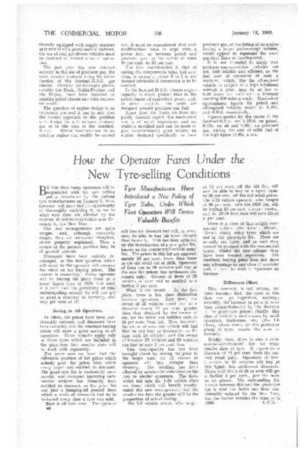How the Operator Fares Under the
Page 106

If you've noticed an error in this article please click here to report it so we can fix it.
New Tyre-selling Conditions
Tyre Manufacturers Have Introduced a New Policy of Tyre Sales, Under Which Fleet Operators Will Derive Valuable Benefits
DY this time many operators will be pacquainted with the new selling
policy introduced by the various tyre manufacturers on January 1. Few. however, will have had the opportunity of thoroughly analysing it, to see in what svay they are affected by the revision of commercial-vehicle-user discounts in the New Year.
The new arrangements are quite unique, and, although extremely, simple, they are somewhat deceptive, unless properly explained. Thus a review of the present position may be of general interest.
Discounts have been entirely rearranged, so the first question which will occur to the operator will concern the effect on his buying prices. The answer is reassuring. Every operator will be buying his giant tyres at a lower figure than in 1938, but (and it is here that the possibility of misunderstanding occurs) he will not get so great a disceunt as formerly, and may get none at all.
Saving ,to All Operators.
In effect, list prices have been considerably reduced, and discounts have been curtailed, but the resultant buying prices will show a great saving to all operators. These remarks apply only to those tyres which are included in the giant-tyre list ; smaller sizes will be dealt with separately.
For years now we have had the ridiculous position of list prices which nobody paid—list prices from which every buyer was entitled to discount. The giant-tyre list is exclusively commercial, and everyone operating commercial vehicles has formerly been entitled to discount, so the price. list was just a jumping-off ground from which a series of discounts had to be deducted every time a tyre was sold.
That is all over now. The operator will lose his discount but will, in every case, be able to buy his tyres cheaper than formerly. This has been achieved by the introduction of a new price list, known as the commercial-vehicle-users' list. The prices in this list are approximately 28 per cent. lower than those in the old retail list of 1938. Operators of from one to 24 vehicles will buy at the new list prices; less settlement discounts only. Owners of fleets of 25 vehicles or over will be entitled to a further 5 per cent.
What is the result? In the first place, there is less class distinction between operators. Last year, the owner of 25 vehicles could buy at a discount nearly 15 per cent, greater than that obtained by the' owner of six, for the latter was entitled only to 15 per cent, from list. Now, however, the owner of even one vehicle will find that he can buy as favourably as the man with 24 vehicles, and the owner of between 25 vehicles and 99 vehicles can buy at only 5 Per cent. less.
This near-equality has not been brought about by raising the price to the larger user, for all classes of operator will buy cheaper than formerly. The levelling has been effected by substantial reductions in the cost to smaller operators. The fleets which fall into the 1-24 vehicle class are those which will benefit mostly, under the new arrangement, but the smaller the fleet the greater will be the proportion of actual saving.
The 1-6 vehicle owner, who bought at 15 per cent, off the old list, will now be able to buy at a figure equal to 28 per cent, off the old retail prices. The 7-24 vehicle operator, who bought at 20 per cent. from the 1938 list, will be buying 10 per cent, cheaper to-day, and the 25-99 fleet man will save about 5 per cent.
There is a class of lightweight commercial vehicle (the 7-cwt., 10-cwt., 12-cwt. class) using tyres which are not in the giant-tyre list. These are actually car tyres, and as such they cannot be grouped with the commercial types. Under the new scheme, they have been treated separately, The resultant buying price does not show any advantage to any class of operator and, in fact, to most it represents an increase.
Differences Offset.
This, however, is not serious, for three reasons ; first, the tyres in this class are not expensive, anyway ; secondly, the increase in price is more than counterbalanced by the decrease in the giant-tyre prices; thirdly, this class of vehicle is used mainly by small operators, tradesmen, etc. (the 1-6 class), whose terms, on this particular group of tyres, remain the same as formerly.
Briefly, then, there is also a commercial-vehicle-users' list for these smaller sizes of tyre. It represents a discount of 15 per cent, from the current retail price. Operators of. from 1 vehicle to 24 vehicles will buy at this figure, less settlement discounts. Those with fleets of 25 or over will get a further 5 per cent., just the same as on giants. The outstanding difference between this and the giant-tyre list is that the latter has been considerably reduced for the New Year, hut the former remains the Same as in 1938.




















































































































































